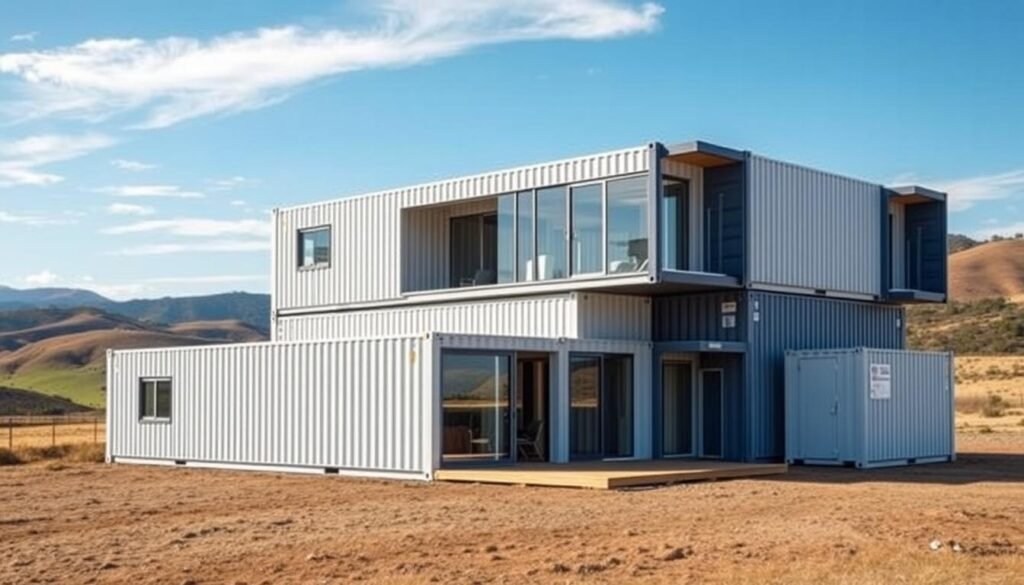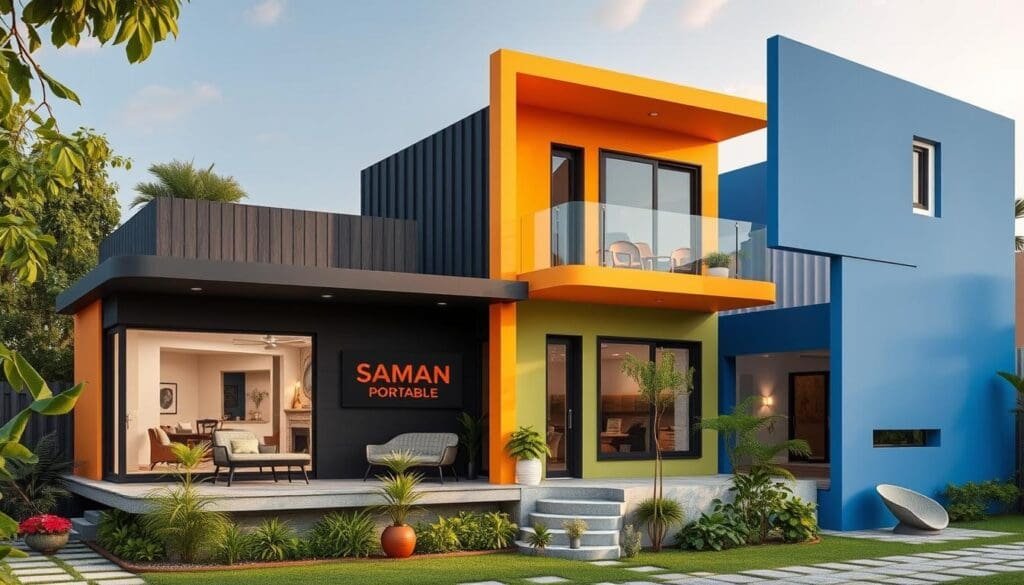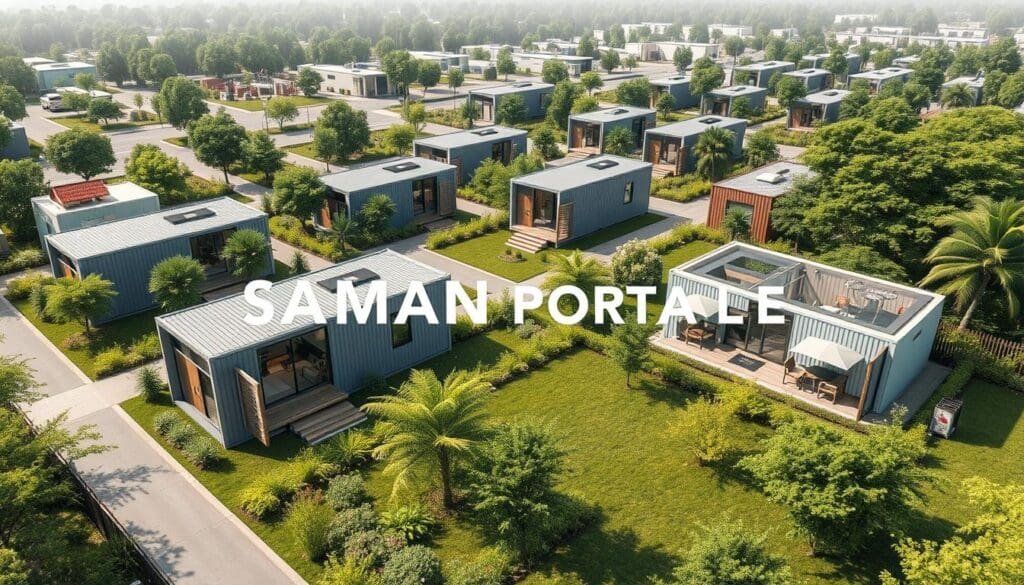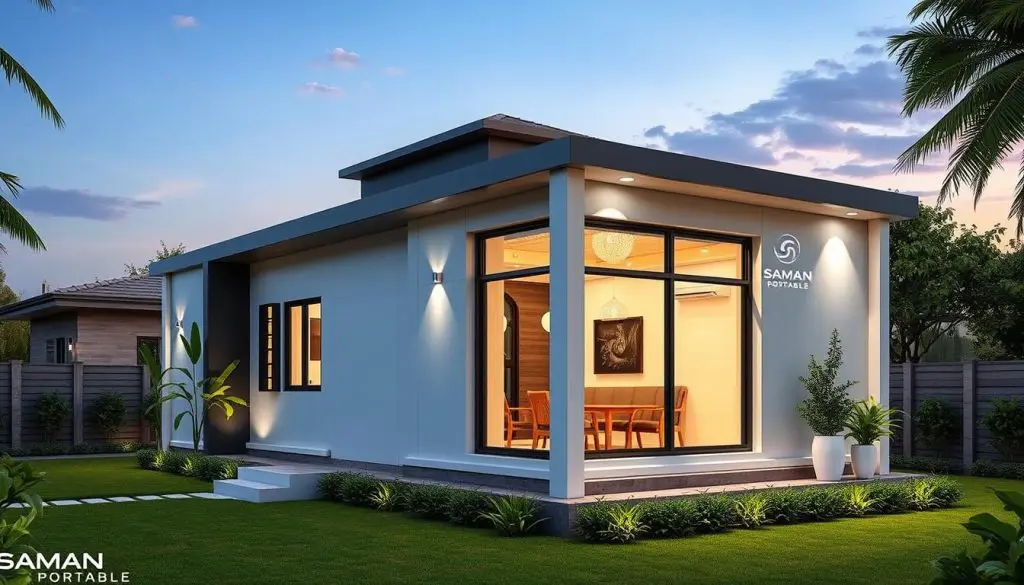Building with Containers Plans: Modern and Creative Ideas
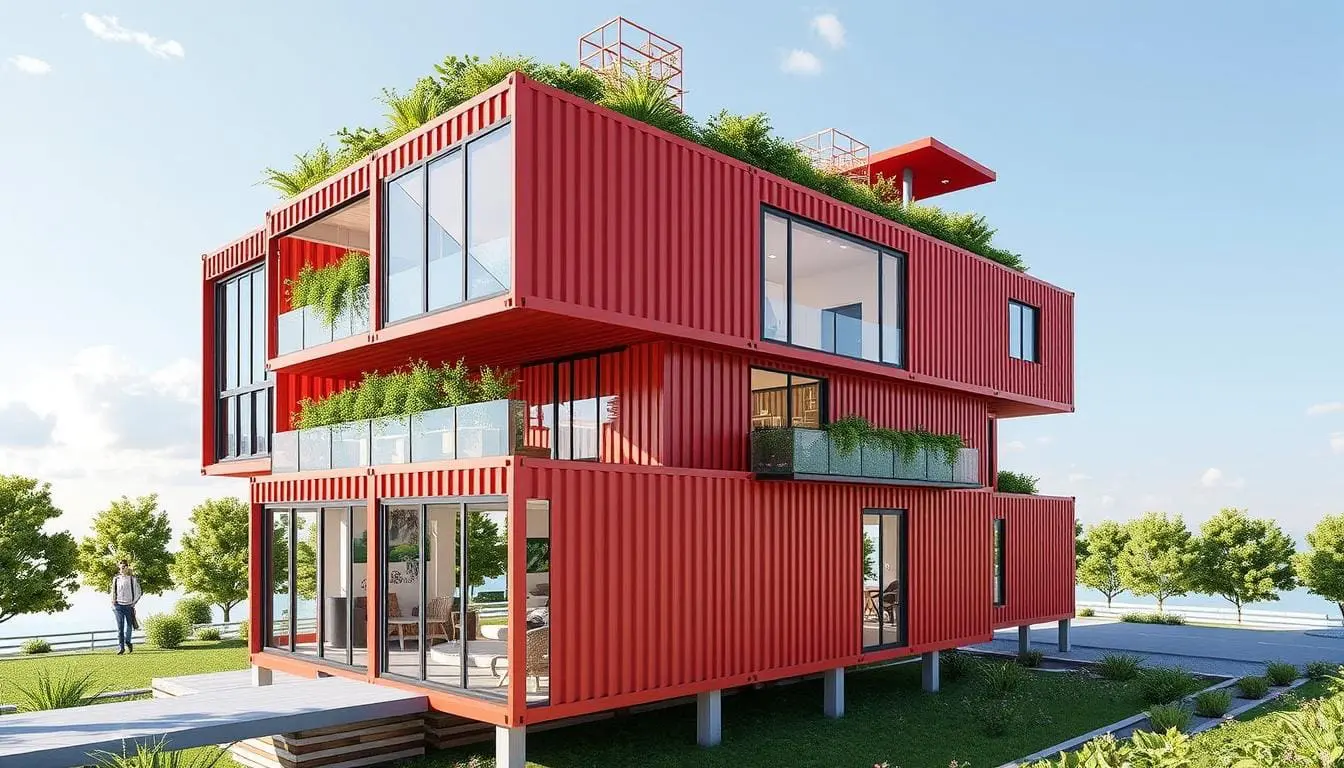
Are you ready to change how you live, work, and play? Discover the power of container architecture. It opens up a world of new ideas. Shipping containers, once just for cargo, now build sustainable, affordable, and beautiful structures.
They can be homes in sleek colors or office spaces that grow with your business. The flexibility of containers is changing what we think of as modern building.
Key Takeaways
- Shipping containers offer versatile and adaptable solutions for diverse living and working spaces.
- Containerized applications range from single-unit tiny homes to multi-container complexes, showcasing the endless design possibilities.
- Container architecture combines environmental responsibility with practical, cost-effective construction methods.
- Shipping containers’ waterproof and durable properties make them suitable for innovative, secure, and sustainable building projects.
- The growing popularity of container homes and commercial spaces highlights the increasing demand for sustainable, customizable, and affordable architectural solutions.
Understanding Container Home Basics and Architecture
Shipping container homes are becoming popular for being affordable and eco-friendly. These shipping container offices and porta cabins use repurposed steel containers. They offer a unique and versatile option for modern living.
Types of Shipping Containers Available
Shipping containers come in different sizes, like 20-foot and 40-foot lengths. Standard height containers are 8’6″ tall. High-cube containers add an extra foot, reaching 9’6″. You can find them new or used, with used being more affordable.
Standard Dimensions and Specifications
- 20-foot container: 20′ x 8′ x 8’6″
- 40-foot container: 40′ x 8′ x 8’6″
- 40-foot high-cube container: 40′ x 8′ x 9’6″
Container Grade Selection Guide
Choosing the right shipping container is key for your container office or porta cabin. Consider the container’s grade, from new to used. Used containers can save money but need a detailed check for safety and water tightness.

Learning about shipping container offices, container office, and porta cabins helps you make smart choices. This way, you can design and build a unique, sustainable living or business space.
Cost-Effective Solutions for Container Construction
Building with containers is exciting because it’s affordable. Prefabricated and steel porta cabins are durable and cheaper than regular construction. They let you build structures for less money.
Using old shipping containers is a big cost saver. These containers are cheaper than new ones. If they’re in good shape, they save you money without losing quality.
To make your container project even cheaper, try these tips:
- Foundation Options: Use concrete slabs, piers, or strip foundations for a strong and affordable base.
- Insulation Solutions: Spray foam insulation is great because it insulates well and is easy to apply, saving on energy costs.
- Maintenance and System Integration: Keep plumbing, electrical, and HVAC systems in good shape to avoid expensive fixes later.
- Budgeting and Cost-Saving Measures: Make a detailed budget and look for ways to save, like DIY projects and using local materials.
Container homes are also good for the planet. They save resources by recycling steel and using less new materials. This is a green choice.

Container construction is appealing for its industrial look and durability. It’s a smart choice for those who want to build affordably and sustainably.
Sustainable Design Principles in Container Architecture
Modern container architecture focuses on sustainability. It turns modular and modern porta cabins into eco-friendly homes and buildings. We use innovative materials and designs to make them look good and be kind to the planet.
Energy Efficiency Features
Insulation and ventilation are key for container buildings. We use materials like reflective barriers and natural sheep wool to keep temperatures right. Solar panels and smart HVAC systems also help save energy.
Eco-Friendly Materials Integration
Using shipping containers is a green choice. It cuts down on waste and supports a circular economy. We pick durable containers and add materials like reclaimed wood and recycled plastic to make them both beautiful and eco-friendly.
Green Building Certification Options
We aim to be green leaders. Many of our projects meet LEED and BREEAM standards. These certifications prove our buildings are built with the environment in mind.

Building with Containers Plans: Essential Steps and Considerations
Planning to build with containers involves several key steps. First, choose a site that fits local laws and zoning rules. Next, get the right shipping containers, like 20-foot or 40-foot ones. Docker containers can help use space well and design in a modular way.
Modifying containers is a big part of the process. You might need to cut out doors and windows, make the structure stronger, and add insulation and climate control. It’s important to plan carefully to use space wisely.
- Site Selection: Check local laws, zoning, and access to find the best spot for your building with containers plans.
- Container Procurement: Pick the right size and quality of container based on your design and budget.
- Modification Planning: Make a detailed plan for changes, insulation, utilities, and finishes.
- Systems Integration: Connect electrical, plumbing, and HVAC systems for a comfy and useful space.

By thinking through these steps and changes, you can make a unique and green building with containers plans. Shipping containers and docker containers ideas can lead to creative and affordable homes.
Modern Container Home Design Trends
In the world of container architecture, new trends are changing how we think about living spaces. These designs mix the tough, industrial look of shipping containers with modern touches. This creates homes that are both striking and functional.
Minimalist Aesthetics
Today’s container homes often go for a minimalist look. They feature clean lines, open spaces, and lots of natural light. Big windows and sliding doors help make the inside feel like the outside.
Placing the containers in a smart way also makes the space feel bigger.
Industrial-Chic Elements
The industrial charm of shipping containers is celebrated in modern designs. You’ll see exposed steel, weathered wood, and old industrial parts. These add depth and personality to the homes.
People love the genuine, raw feel of these containers. It’s a mix of old and new that works well together.
Contemporary Finishing Options
To balance the industrial look, modern homes add modern touches. You might see sleek cabinets, new appliances, and fancy finishes like quartz or polished concrete. These details make the containers into cozy, stylish homes.

Look at the Union Pier Container Home Two in Western Michigan or the Foster Container Home in Colorado. These homes show how container architecture and modern porta cabins can be versatile and stylish. They mix old and new to create something truly unique.
Structural Modifications and Engineering Requirements
Turning shipping containers into container offices needs careful changes and engineering skills. These strong steel boxes, made for sea travel, must adapt to land use. They must be safe and stable.
Reinforcing windows, doors, and other features is key. Cutting into the container can weaken it. So, special engineering checks and fixes are needed. It’s vital to keep the container strong and sound.
Designing shipping container offices with many units adds complexity. It’s important to make sure they work together well. Engineers must look at stress points and how loads are spread. This ensures the whole building is safe and solid.
- Reinforcing openings for windows, doors, and architectural elements
- Maintaining the container’s load-bearing capacity during modifications
- Addressing load-bearing and integration challenges in multi-container configurations
- Obtaining necessary engineering approvals and meeting building code requirements

Good engineering is essential for making container offices safe and useful. With skilled engineers, designers, and builders, modifications can meet safety and building codes. This leads to creative and green office spaces.
Interior Layout Optimization Strategies
Designing a home with porta cabins or prefabricated porta cabins means making the most of space. Container homes let us get creative with layouts that are both efficient and functional. We can use space-saving solutions and multi-functional furniture to make the most of the space in shipping containers.
Space-Saving Solutions
Porta cabins and prefabricated porta cabins have limited space. So, using space wisely is key. Solutions like fold-down tables, hidden storage, and furniture that changes function can help. These ideas help us create a space that feels big and welcoming.
Multi-functional Furniture Ideas
In porta cabins or prefabricated porta cabins, furniture that does more is a must. Choosing items like ottomans with storage, Murphy beds, and sofas that turn into beds saves space. These pieces help us change the layout to fit different needs, from relaxing to sleeping.
Storage Integration Techniques
Good storage is crucial in porta cabins and prefabricated porta cabins. Using the vertical space, built-in cabinets, and furniture undersides helps a lot. Placing shelves, drawers, and hidden spots smartly makes sure we use every inch of the home.

Container Home Insulation and Climate Control
Insulation is key when building steel porta cabins or modular porta cabins. It keeps the inside warm or cool and saves energy. There are many insulation choices, each with its own benefits and things to think about.
Spray foam insulation is a top pick. It has high R-values and fits perfectly in the container. It stops air and moisture from getting in, keeping the temperature steady.
Rigid board insulation, like EPS or XPS, is another good choice. It has a high R-value and fits well in the container’s walls.
Batt insulation, made from fiberglass or mineral wool, is great for living and work spaces. It’s affordable and boosts the container’s warmth and soundproofing. Mineral wool is also fire-resistant and keeps water out, making it perfect for many designs.

Container homes use energy-saving HVAC systems to handle their unique needs. Good insulation and sealing are key to making these systems work well. This cuts down energy use and lowers bills. By picking the right insulation and HVAC, homes become cozy, green, and budget-friendly.
Electrical and Plumbing Systems Installation
Turning modern porta cabins or container offices into homes needs careful planning. Electrical and plumbing systems must be installed safely and efficiently. This includes making sure power is distributed well and water is managed effectively in small spaces.
Power Distribution Planning
Getting the electrical system right is key in container homes. We need to design it to handle the expected load and follow local codes. This might mean upgrading the main panel, placing outlets wisely, and using energy-saving lights.
Water Management Solutions
Good water management is vital in container homes. We can save water by using low-flow fixtures, tankless heaters, and graywater systems. Planning the plumbing layout carefully helps use space well and ensures water flows smoothly.
HVAC Integration Methods
Adding HVAC systems to container offices requires creative solutions. Options like split systems or ductless mini-splits are compact and save energy. They keep the space comfortable without taking up too much room.

By tackling the special needs of electrical and plumbing in modern porta cabins and container offices, we can make them sustainable and useful. Planning well, installing professionally, and using eco-friendly options are key to a successful project.
Multi-Container Home Configurations
Shipping container architecture offers endless possibilities for home designs. By linking multiple containers, we can build bigger, more complex homes. These designs can include different levels, open layouts, and separate living and work areas.
One big plus of using multiple containers is their flexibility. They can be set up in many ways, letting homeowners tailor their homes to their needs. This might mean stacking containers for multi-story homes or arranging them side-by-side for open spaces.
When combining containers, making sure they’re safe and sturdy is key. Experts like architects and engineers are crucial in this process. They ensure the structure meets all safety and building codes.
Using multiple containers can also save money. It’s a way to add more space without the high costs of traditional building. This makes it a cost-effective option for those looking to expand their living areas.
The appeal of container architecture is growing as people seek sustainable housing. Embracing multi-container designs opens up new ways to live and work responsibly. It’s a step towards a greener future.
Outdoor Living Space Integration
Building with containers opens up new ways to create outdoor living spaces. You can design decks that expand your living area or add rooftop gardens for greenery and better insulation. These modular structures make it easy to blend indoor and outdoor spaces, even in small areas.
Container Deck Designs: Extending the Living Space
Use bi-fold or sliding doors to connect indoor and outdoor areas smoothly. Plan your courtyard into zones for dining, lounging, and gardening. Choose compact furniture and UV-resistant materials to keep the space looking good and lasting long.
Rooftop Garden Options: Bringing Nature to New Heights
A rooftop garden brings greenery and boosts your home’s energy efficiency. Pick low-maintenance plants like succulents for a beautiful, easy-care garden. Add string lights and solar lanterns for a magical feel in your outdoor space.
Exterior Entertainment Areas: Maximizing Versatility
Exterior entertainment areas show how versatile containers can be. Mix different lights for a unique look and add personal touches like colorful tapestries. Consider a game area for fun and relaxation.
By integrating outdoor spaces into your container home, you create a special living experience. It combines the best of both worlds, indoors and outdoors.
Legal Requirements and Building Codes
Building porta cabins and prefabricated structures requires understanding legal rules. These rules change based on where you are. You need to follow zoning laws, get the right permits, and meet safety standards.
Porta cabins and prefabricated structures have different rules in different places. In the U.S., California has strict building codes for earthquake safety. Texas has looser rules. In India, new building laws aim to make getting approval easier.
It’s key to work with local experts and authorities. They can guide you through zoning, permits, and changes to your structure. This teamwork helps avoid legal problems during construction.
Structural inspections are also vital. They check if your structure is safe and meets standards. Passing these checks is needed to get approval for your project.
Knowing the legal rules helps your construction go smoothly. Stay informed and work with experts to create green and innovative spaces. These spaces will meet all necessary regulations.
- Zoning regulations determine where porta cabins and prefabricated structures can be built, often dividing areas into residential and commercial zones.
- Building permits demonstrate adherence to construction standards and are required to gain approval for container home projects.
- Structural inspections assess the integrity and safety of container-based structures, including insulation, windows, doors, and modifications.
- Regulations can vary significantly across regions, requiring collaboration with local authorities and experienced professionals.
By understanding legal rules, you can fully use porta cabins and prefabricated structures. You can create green and innovative spaces that follow all laws.
Creative Container Business Applications
Shipping containers are changing the business world. They offer creative solutions for many industries. From container offices to pop-up stores, docker containers inspire new ideas in retail, hospitality, and events.
These structures are easy to move and change. They open up new chances for businesses to create unique and useful spaces. Whether it’s a short-term pop-up or a long-term mobile office, container offices are gaining popularity for their cost and style.
In the hospitality field, shipping containers are turned into cool cafes, restaurants, and bars. They give customers a special dining experience. Event planners also use docker containers as stages, exhibition areas, and VIP areas.
The use of shipping containers for business spaces is growing fast. It shows how these structures can be used in many ways. By focusing on sustainability, companies can make green and energy-saving spaces that show off their brand and meet the need for new and useful places.
From schools to mobile offices, turning shipping containers into flexible spaces is both green and useful. SAMAN Portable Office Solutions provides custom solutions. They make sure each project fits the client’s needs and goals.
Conclusion
Building with containers is a smart way to build homes and offices. It’s good for the planet, saves money, and lets you design freely. This method is changing how we build, offering new ways to live and work.
Shipping containers are strong and can be used in many ways. They appeal to architects, designers, and homeowners looking for something different. You can make a small studio or a big house using containers, meeting many needs.
The need for green and flexible spaces is growing. Container construction is set to keep getting better. With new ways to keep things warm, use energy, and design inside, container homes are changing architecture. They’re leading the way in building that’s good for the environment and modern.
FAQ
What are the different types of shipping containers available for building?
Shipping containers come in sizes like 20ft x 8ft and 40ft x 8ft. They have heights of 8’6″ or 9’6″ for more space. The condition of the container, from new to used, affects its cost and quality.
How do container homes offer a cost-effective alternative to traditional construction?
Container homes are cheaper than traditional houses. They include quick, affordable options like porta cabins. These are great for temporary or permanent needs.
What sustainable design principles are important in container architecture?
Sustainable design in container homes focuses on saving energy. This includes insulation, solar panels, and smart HVAC systems. Using eco-friendly materials and green practices is key to a responsible build.
What are the essential steps in creating effective building with containers plans?
Planning for container buildings involves several steps. You need to check local laws, think about the structure, and set design goals. This includes choosing a site, buying containers, planning modifications, and integrating systems. The docker concept helps in using space well and designing modules.
What are the current trends in container architecture aesthetic?
Today, container architecture leans towards simple designs. It uses the containers’ industrial look. Modern designs include big windows, sliding doors, and modern finishes. This creates bright, open spaces that contrast with the container’s look.
What structural modifications are required for container offices?
Making container offices safe and functional needs expert engineering. You’ll need to strengthen windows and doors, plan for multiple containers, and handle weight issues. Good engineering ensures the office is stable and meets codes.
How can space be maximized in porta cabins?
To make the most of porta cabins, use smart layouts. Solutions like fold-down tables and multi-use furniture save space. These ideas help make the most of shipping containers’ limited space.
How is insulation and climate control addressed in steel porta cabins?
Insulation is key in steel porta cabins to keep temperatures right and save energy. Methods include spray foam, rigid board, or a mix. For climate control, efficient HVAC systems are used, designed for container challenges.
What considerations are involved in installing electrical and plumbing systems in modern porta cabins?
Installing electrical and plumbing in modern porta cabins needs careful planning. You must fit systems safely and efficiently in the limited space. HVAC systems in offices often use split systems or ductless mini-splits for space and energy savings.
How can multi-container configurations expand the possibilities of container architecture?
Using more than one container opens up new possibilities. You can build bigger homes and complex offices. Designs can have levels, open layouts, or separate areas. But, joining containers requires careful planning for stability and safety.
What are the legal requirements and building codes to consider when constructing porta cabins and prefabricated structures?
When building porta cabins and prefabs, following laws and codes is essential. Rules vary by area and include permits, zoning, and safety. Working with local experts ensures you meet requirements and avoid legal problems.
What creative business applications are possible with container offices?
Container offices offer many business uses, from pop-up shops to mobile offices. Their flexibility inspires new uses in retail, hospitality, and events. These structures are easy to move and change, offering unique spaces for businesses.
 Container Cafe
Container Cafe

















































































